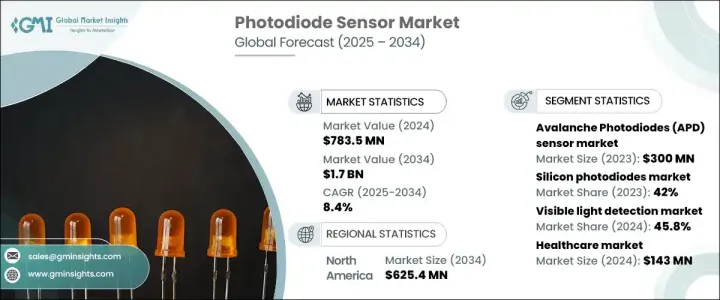PUBLISHER: Global Market Insights Inc. | PRODUCT CODE: 1698512

PUBLISHER: Global Market Insights Inc. | PRODUCT CODE: 1698512
Photodiode Sensors Market Opportunity, Growth Drivers, Industry Trend Analysis, and Forecast 2025-2034
The Global Photodiode Sensors Market reached USD 783.5 million in 2024 and is projected to grow at a CAGR of 8.4%, reaching USD 1.7 billion by 2034. Market growth is driven by rising demand for these sensors in optical communication, medical imaging, and industrial automation. As industries move toward more advanced and precise sensing technologies, photodiode sensors are playing a crucial role in enhancing performance and efficiency. The increasing adoption of optical fiber networks, advancements in imaging technologies, and automation trends in manufacturing sectors are fueling demand. The shift toward smart devices, including consumer electronics and automotive applications, is further contributing to market expansion.

Photodiode sensors are classified based on type into avalanche photodiodes (APD), PN photodiodes, and PIN photodiodes. The avalanche photodiode sensor market reached USD 300 million in 2023, largely due to its high sensitivity and rapid response time, making it ideal for optical fiber communication. With the growing reliance on high-speed data transmission, the adoption of APD sensors continues to rise, supporting advancements in communication networks. These sensors provide superior signal amplification, making them a preferred choice for industries requiring precise and fast light detection.
| Market Scope | |
|---|---|
| Start Year | 2024 |
| Forecast Year | 2025-2034 |
| Start Value | $783.5 million |
| Forecast Value | $1.7 billion |
| CAGR | 8.4% |
Market segmentation by material includes silicon photodiodes, InGaAs photodiodes, and germanium photodiodes. Silicon photodiodes held a 42% share in 2023 due to their cost efficiency, reliability, and fast response time. Their widespread use in consumer electronics is fueling growth as manufacturers seek high-performance yet affordable sensor solutions. The InGaAs photodiodes market is expected to generate USD 548 million by 2034, driven by its exceptional sensitivity in the near-infrared to shortwave infrared spectrum, making it a preferred choice for high-precision applications. These sensors are widely utilized in specialized imaging, spectroscopy, and industrial automation, contributing to their expanding market share.
North America photodiode sensors market is projected to reach USD 625.4 million by 2034. This expansion is attributed to major industry players incorporating photodiode sensors into a wide range of electronic devices, including smartphones, wearables, and augmented reality systems. The US market is experiencing strong demand due to increasing passenger vehicle sales and the growing adoption of photodiode sensors in automotive safety applications. These sensors play a crucial role in advanced driver-assistance systems, enabling features such as object detection, lane departure warnings, and parking assistance.
Table of Contents
Chapter 1 Methodology & Scope
- 1.1 Market scope & definitions
- 1.2 Base estimates & calculations
- 1.3 Forecast calculations
- 1.4 Data sources
- 1.4.1 Primary
- 1.4.2 Secondary
- 1.4.2.1 Paid sources
- 1.4.2.2 Public sources
Chapter 2 Executive Summary
- 2.1 Industry synopsis, 2021-2034
Chapter 3 Industry Insights
- 3.1 Industry ecosystem analysis
- 3.1.1 Factor affecting the value chain
- 3.1.2 Profit margin analysis
- 3.1.3 Disruptions
- 3.1.4 Future outlook
- 3.1.5 Manufacturers
- 3.1.6 Distributors
- 3.2 Supplier landscape
- 3.3 Profit margin analysis
- 3.4 Key news & initiatives
- 3.5 Regulatory landscape
- 3.6 Impact forces
- 3.6.1 Growth drivers
- 3.6.1.1 Rising adoption of optical communication systems
- 3.6.1.2 Increasing demand for consumer electronics
- 3.6.1.3 Expansion in healthcare applications
- 3.6.1.4 Rising awareness of renewable energy
- 3.6.2 Industry pitfalls & challenges
- 3.6.2.1 Lower temperature stability
- 3.6.2.2 Increasing availability of alternatives
- 3.6.1 Growth drivers
- 3.7 Growth potential analysis
- 3.8 Porter's analysis
- 3.9 PESTEL analysis
Chapter 4 Competitive Landscape, 2024
- 4.1 Introduction
- 4.2 Company market share analysis
- 4.3 Competitive positioning matrix
- 4.4 Strategic outlook matrix
Chapter 5 Market Estimates & Forecast, By Type, 2021-2034 (USD Million & Unit)
- 5.1 Key trends
- 5.2 Avalanche Photodiodes (APD)
- 5.3 PN photodiodes
- 5.4 PIN photodiodes
Chapter 6 Market Estimates & Forecast, By Material, 2021-2034 (USD Million & Unit)
- 6.1 Key trends
- 6.2 Silicon photodiodes
- 6.3 InGaAs photodiodes
- 6.4 Germanium photodiodes
Chapter 7 Market Estimates & Forecast, By Functionality, 2021-2034 (USD Million & Unit)
- 7.1 Key trends
- 7.2 Visible light detection
- 7.3 Infrared light detection
- 7.4 Ultraviolet light detection
Chapter 8 Market Estimates & Forecast, By Technology, 2021-2034 (USD Million & Unit)
- 8.1 Key trends
- 8.2 Surface-Mount Technology (SMT)
- 8.3 Through-Hole Technology (THT)
Chapter 9 Market Estimates & Forecast, By Integration Level, 2021-2034 (USD Million & Unit)
- 9.1 Key trends
- 9.2 Discrete photodiodes
- 9.3 Integrated photodiode sensors
Chapter 10 Market Estimates & Forecast, By End Use, 2021-2034 (USD Million & Unit)
- 10.1 Key trends
- 10.2 Automotive
- 10.3 Consumer electronics
- 10.4 Healthcare
- 10.5 Industrial
- 10.6 Aerospace & defense
- 10.7 Others
Chapter 11 Market Estimates & Forecast, By Region, 2021-2034 (USD Million & Unit)
- 11.1 Key trends
- 11.2 North America
- 11.2.1 U.S.
- 11.2.2 Canada
- 11.3 Europe
- 11.3.1 UK
- 11.3.2 Germany
- 11.3.3 France
- 11.3.4 Italy
- 11.3.5 Spain
- 11.3.6 Russia
- 11.4 Asia Pacific
- 11.4.1 China
- 11.4.2 India
- 11.4.3 Japan
- 11.4.4 South Korea
- 11.4.5 Australia
- 11.5 Latin America
- 11.5.1 Brazil
- 11.5.2 Mexico
- 11.6 MEA
- 11.6.1 South Africa
- 11.6.2 Saudi Arabia
- 11.6.3 UAE
Chapter 12 Company Profiles
- 12.1 Centronic, Ltd
- 12.2 Excelitas Technologies Corporation
- 12.3 Vishay Intertechnology, Inc
- 12.4 ams-Osram AG
- 12.5 First Sensor AG (TE Connectivity)
- 12.6 Everlight Americas, Inc
- 12.7 Clairex Technologies, Inc.
- 12.8 Semiconductor Components Industries, LLC
- 12.9 TT Electronics Plc
- 12.10 OSI Optoelectronics
- 12.11 Nisshinbo Micro Devices
- 12.12 Everlight Electronics
- 12.13 AC Photonics, Inc.
- 12.14 Opto Diode Corporation
- 12.15 OSI Laser Diode, Inc.




